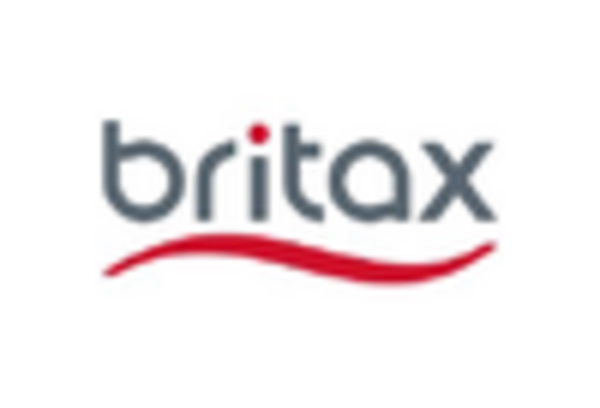Rising Awareness of Child Safety
The increasing awareness of child safety is a pivotal driver for the baby safety-seats market. Parents are becoming more informed about the potential risks associated with inadequate safety measures during travel. This heightened consciousness is reflected in the growing demand for safety seats that meet stringent safety standards. According to recent data, approximately 75% of parents prioritize safety features when selecting a baby safety seat. This trend indicates a shift towards products that offer advanced protection, thereby propelling the market forward. Furthermore, educational campaigns by government agencies and non-profit organizations have contributed to this awareness, emphasizing the importance of using certified safety seats. As a result, the baby safety-seats market is likely to experience sustained growth as parents increasingly seek out products that ensure the utmost safety for their children.
Increase in Birth Rates and Family Size
The increase in birth rates and family size in the United States is a fundamental driver for the baby safety-seats market. As families grow, the need for multiple safety seats becomes apparent, leading to higher overall sales. Recent statistics indicate that the birth rate has seen a modest increase, with families opting for more children, which directly correlates with the demand for safety seats. Additionally, larger families often require various types of safety seats to accommodate different age groups, further boosting market growth. This demographic trend suggests that the baby safety-seats market will continue to thrive as more families prioritize safety and compliance with regulations. Consequently, manufacturers may need to diversify their product lines to cater to the evolving needs of larger families.
Technological Advancements in Safety Features
Technological advancements are reshaping the baby safety-seats market by introducing innovative safety features that appeal to modern parents. The integration of smart technology, such as sensors and mobile applications, allows parents to monitor their child's safety in real-time. For example, some safety seats now come equipped with alerts that notify parents if the seat is improperly installed or if the child unbuckles themselves. This trend towards incorporating technology not only enhances safety but also provides convenience, making it a compelling selling point. Market data suggests that products featuring advanced technology are witnessing a growth rate of approximately 20% annually. As manufacturers continue to invest in research and development, the baby safety-seats market is expected to expand, driven by consumer demand for high-tech safety solutions.
Legislative Support for Child Restraint Systems
Legislative measures mandating the use of child restraint systems are significantly influencing the baby safety-seats market. Various states have enacted laws requiring the use of appropriate safety seats for children, which has led to a surge in demand for compliant products. For instance, as of 2025, nearly 48 states have implemented laws that necessitate the use of safety seats for children up to a certain age or weight. This regulatory framework not only enhances child safety but also drives market growth by compelling parents to purchase safety seats that adhere to these legal requirements. The baby safety-seats market is thus positioned to benefit from ongoing legislative efforts aimed at improving child safety during vehicular travel. As these laws evolve, manufacturers are likely to innovate and enhance their offerings to meet compliance, further stimulating market dynamics.
Consumer Preference for Quality and Brand Reputation
Consumer preference for quality and brand reputation is increasingly shaping the baby safety-seats market. Parents are more inclined to invest in reputable brands known for their commitment to safety and reliability. This trend is underscored by the fact that approximately 60% of parents are willing to pay a premium for safety seats from established brands. The perception of quality is often linked to rigorous testing and certification processes, which further influences purchasing decisions. As a result, manufacturers are focusing on enhancing their brand image and ensuring that their products meet or exceed safety standards. This emphasis on quality not only fosters consumer trust but also drives competition within the baby safety-seats market, as brands strive to differentiate themselves through superior safety features and customer service.

















Leave a Comment